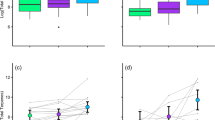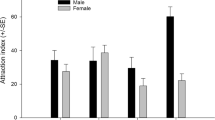Summary
The twolined chestnut borer, Agrilus bilineatus (Weber) (Coleoptera: Buprestidae), attacks stressed oaks (Quercus spp.) and is associated with extensive mortality of trees in the eastern deciduous forests of North America. We examined host location by the insect and subsequent host mortality in experimentally stressed trees. A. bilineatus adults were able to rapidly and specifically locate stressed oak trees. Up to 160 beetles per week were captured on sticky band traps on the trunks of stressed trees, while beetles rarely landed on unstressed control trees. This suggests that adult borers have an acute perception of host tree “quality”, and that this perception is from a distance. One mechanism of host location may be detection of volatile compounds produced by stressed trees.
The condition of the host tree appears to regulate both beetle attraction and successful colonization. Mortally wounded (xylem-girdled) trees attracted beetles only until the cambium died. Xylem-girdled trees were attacked early in the beetle flight season, but larvae did not survive to emerge as adults from these trees. In contrast, phloemgirdled trees continued to attract beetles throughout the flight period. Phloem-girdled trees which were heavily attacked by A. bilineatus died late in the season in which they were attacked. Lightly attacked trees survived until the following growing season, and were then heavily attacked and killed. In one stand, phloem-girdled trees were not attacked, healed over the girdling wounds and were still alive three years after girdling. These results indicate that oak trees are only attractive to A. bilineatus within a narrow range of physiological conditions following stress but prior to mortality. A. bilineatus appears to be a proximate agent of mortality in stressed oaks in eastern North America.
Similar content being viewed by others
References
Bormann FH, Graham BF Jr (1960) Translocation of silvicides through root grafts. J For 58:402–403
Cote WA, Allen DC (1980) Biology of two-lined chestnut borer, Agrilus bilineatus, in Pennsylvania and New York. Ann Entomol Soc Am 73:409–413
Dunbar DM, Stephens GR (1975) Association of two-lined chestnut borer and shoestring fungus with mortality of defoliation oak in Connecticut. For Sci 22:169–174
Dunbar DM, Stephens GR (1976) The bionomics of the twolined chestnut borer. In: Anderson JF, Kaya HK (eds) Perspectives in Forest Entomology. Academic Press, pp 73–86
Dunn JP (1985) Attraction of the twolined chestnut borer, Agrilus bilineatus Weber, and other associated borers to stressed white oak, Quercus alba L. Master of Science Thesis, University of Kentucky, p 113
Dunn JP, Kimmerer TW, Nordin GL (1986) Attraction of the twolined chestnut borer, Agrilus bilineatus (Weber) (Coleoptera: Buprestidae) and associated borers to volatiles of stressed white oak. Can Entomol 118:503–509
Evert RF, Kozlowski TT, Davis JD (1972) Influence of phloem blockage on cambial growth of Acer saccharum. Am J Bot 49:632–641
Feeny P (1976) Plant apparency and chemical defense. Coevolution. Harborne JB (ed). Academic Press, London. Rec Adv Phytochem 10:1–40
Haack RA, Benjamin DM (1982) The biology and ecology of the two-lined chestnut borer, Agrilus bilineatus, on oaks, Quercus spp in Wisconsin. Can Entomol 114:385–395
Horn GH (1891) The species of Agrilus of boreal America. Trans Am Entomol Soc 18:277–336
Kozlowski TT, Keller T (1976) Food relations of woody plants. Bot Rev 32:293–382
Rhoades DF (1983) Hervivore population dynamics and plant chemistry. In: Denno RS, McClure MS (eds) Variable plants and herbivores in natural and managed systems, pp 120–135
Rhoades DF, Cates DG (1976) Toward a general theory of plant antihervivore chemistry. Rec Adv Phytochem 10:168–213
Scholander PF, Hammel HT, Bradsheet ED, Hemingsen EA (1965) Sap pressure in vascular plants. Science 148:339–346
Snedecor GW, Cochran WG (1980) Statistical methods. Iowa State University Press, pp 1–507
USDA (1974) Soil survey of Estill and Lee Counties, Kentucky, pp 1–87
White TCR (1984) The abundance of invertebrate herbivores in relation to the availability of nitrogen in stressed food plants. Oecologia (Berlin) 63:90–105
Author information
Authors and Affiliations
Additional information
This paper (85-7-8-216) resulted from a project of the Kentucky Agricultural Experiment Station and is published with the approval of the Director
Rights and permissions
About this article
Cite this article
Dunn, J.P., Kimmerer, T.W. & Nordin, G.L. The role of host tree condition in attack of white oaks by the twolined chestnut borer, Agrilus bilineatus (Weber) (Coleoptera: Buprestidae). Oecologia 70, 596–600 (1986). https://doi.org/10.1007/BF00379911
Received:
Issue Date:
DOI: https://doi.org/10.1007/BF00379911




